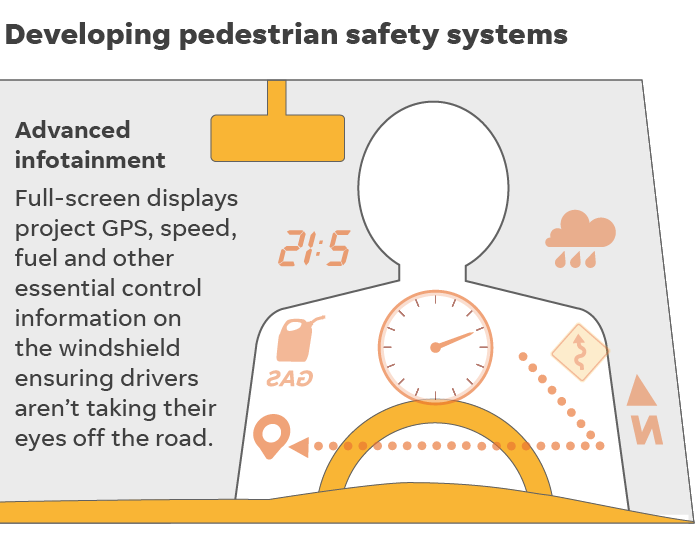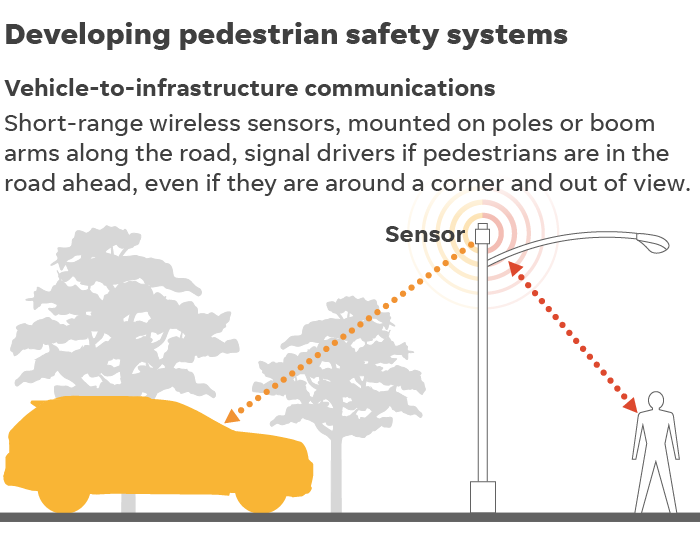Engineering Pedestrian Safety
July 02, 2018
The need for advanced technologies to prevent cars from striking people is gaining greater urgency amid heightened awareness of the nation’s pedestrian safety crisis.
Automakers and suppliers are developing an array of systems to avert accidents, including safer infotainment systems and crash-avoidance technology.
About 73-80 percent of new vehicles sold in 2018 are expected to come with some form of crash-avoidance system, said Tom Mayor, industrial manufacturing strategy practice leader at KPMG.
But those systems are largely focused on protecting people inside the vehicle, not outside the vehicle.
Here are several ways auto companies are pursuing systems that will look out for pedestrians:
Automatic Braking
Automakers representing more than 99 percent of vehicles sold in the U.S. have voluntarily committed to including automatic emergency braking systems as standard technology in all new vehicles by 2022.
But more advanced systems, which improve pedestrian safety by avoiding walkers who are not visible to the driver, are already available in other markets.
There are systems that uses radar and cameras to detect pedestrians and cyclists within a 20-meter radius and deploy automatic emergency braking in less time than it takes to blink twice. These systems can spot pedestrians through a cloud of steam rising from vents along urban pavement.
Automakers have been slow to implement even the most basic emergency braking systems as they proceed toward their 2022 commitment. Only four of the 20 automakers that made the voluntary pledge had made the technology standard on at least half of their 2017 models, according to the National Highway Traffic Safety Administration.
Vehicle-to-Infrastructure
Enabling vehicles to communicate with road equipment, and the other way around, is envisioned as a key way to promote pedestrian safety.
An auto supplier is developing a system that uses short-range wireless communication to transmit signals from above-the-intersection equipment that detects pedestrians and conveys the information to vehicles in the area.
The system is set for a real-world pilot debut in Columbus, Ohio, as part of a U.S. Transportation Department initiative in 2019.
One key benefit: The detection equipment can alert vehicles to avoid jaywalking pedestrians around the corner on streets that even the most advanced vehicle’s on-board technology has no ability to assess.
The problem: It will take decades for all cars to come equipped with such systems. In addition, government spending on basic infrastructure has been lacking.

Advanced Infotainment
The crisis of distraction has worsened with complex touch-screen infotainment systems that take the driver’s eyes off the road.
But automakers and suppliers are developing augmented-reality systems that project directions onto the windshield.
Improved Headlights
While advanced technologies get much of the publicity, improving pedestrian safety requires a renewed focus on the basics of automotive design and engineering.
Poor headlight performance is a shortcoming for the automotive industry for a variety of reasons, including ancient regulations that have prevented engineers from adopting technology that automatically controls lighting dispersal to reduce glare and help drivers see better.
The Insurance Institute for Highway Safety has conducted a series of tests in recent years that have shown many cars, including luxury vehicles, to be lacking adequate headlights.
Self-Driving Systems
The National Highway Traffic Safety Administration hopes self-driving cars will play a key role in meeting its ambitious goal of eliminating all road deaths within about three decades.
Most major automakers and many tech companies are pursuing vehicles that can drive themselves.
Someday, they may be able to prevent pedestrian fatalities in which the driver would have been at fault in the past, as well as many in which the pedestrian made a mistake.
The challenge for auto and tech companies is to perfect the systems to adapt to every single possible scenario. Even then, cars will not be able to avoid all pedestrians.
Bomey, Nathan. (2018). “Death on foot: 5 ways new car tech could save pedestrians”. Retrieved from https://www.freep.com/story/money/cars/2018/06/28/pedestrian-deaths-car-technology/646543002/.
